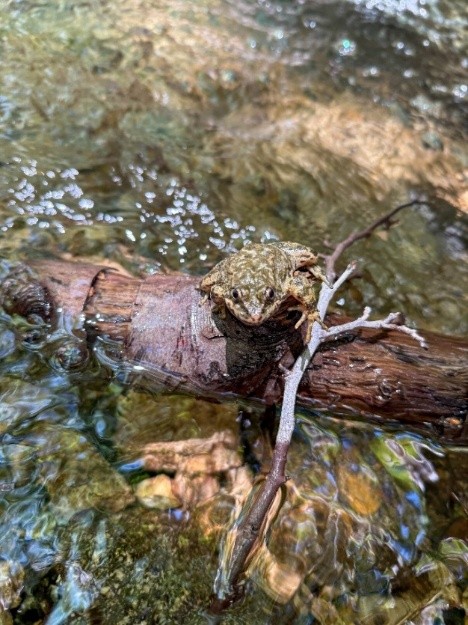L.A. Zoo-Bred Subadult Southern Mountain Yellow-Legged Frogs Also Released

AMAZING PHOTO/VIDEO OF FROG RELEASE:
CLICK HERE – (Credit: © Los Angeles Zoo)
LOS ANGELES, CA – July 10, 2025 – The Los Angeles Zoo, along with U.S. Geological Survey (USGS) conservationists and staff from the Aquarium of the Pacific, released 450 tadpoles and 193 subadult southern mountain yellow-legged frogs (Rana muscosa) to the cool streams of the San Gabriel Mountains, where the species was once abundant. With the exception of 38 frogs that were rescued in 2024, all of the tadpoles and frogs were bred at the Los Angeles Zoo where staff has been breeding the endangered species since 2007.
The species is being bred for release at the L.A. Zoo as part of a long-running conservation program led by the USGS. Members of the L.A. Zoo Animal Care team trekked alongside program partners to the remote release site where the tadpoles and frogs were released into their native range. The exact location of the release is not disclosed for the protection of the animals and their fragile ecosystem.
“The L.A. Zoo has taken another major step in recovering a local endangered species with our successful southern mountain yellow-legged frog breeding program,” said Byron Wusstig, Curator of Ectotherms at the Los Angeles Zoo. “I look forward to seeing these tadpoles and frogs help repopulate these remote areas of the San Gabriel Mountains and to continue innovative breeding and husbandry practices that support this long-running recovery effort with the USGS and partners.”
The recovery program was established to bolster populations in the wild in an effort to save this species from extinction. Frogs bred at the Los Angeles Zoo are hatched and raised with the help of zoo and aquarium partners, including the Aquarium of the Pacific, to ensure their development beyond their most vulnerable state. Once they are mature enough, they are released into natural habitats, giving them a better chance of avoiding predation and other threats. Since 2007, when the breeding colony was established at the L.A. Zoo, more than 6,000 L.A. Zoo-bred offspring have been released into the San Gabriel Mountains and surrounding habitats.
“This was my second time on a southern mountain yellow-legged frog release,” said Luc Myers, an Animal Keeper at the Los Angeles Zoo. “Hiking out on the San Gabriels with a cooler on my back, carrying these precious frogs was nothing short of amazing. I’m thrilled I could play a part in this larger recovery effort and work with the USGS and our partners in the recovery program to help this endangered frog that calls Southern California home.”
To help with managed breeding efforts, the L.A. Zoo designed a bio-secure amphibian breeding room to create a quiet, temperature-controlled environment for the tadpoles being brought to the Zoo’s breeding program. Built by Zoo staff, the room is equipped with life support and water quality technology to provide the most optimal conditions for this sensitive species of frog.
This year, the L.A. Zoo is expanding its efforts and is currently creating a headstarting facility on-site at the Zoo. An unused space in the Zoo’s Children’s Discovery Center is being renovated and outfitted with specialized tanks and equipment to safely house frogs as they mature. The L.A. Zoo’s animal care team will soon have the ability to move tadpoles into the new facility where they will be allowed to grow to a more robust size prior to release into the wild. By giving the tadpoles the opportunity to mature, or a headstart, the survivability rates are likely to increase as mature frogs are less susceptible to predation by other animals in the environment.
The Southern Mountain Yellow-Legged Frog Recovery Program is a collaborative endeavor, under the leadership of the USGS, formed in 2006 between the Los Angeles Zoo, the San Diego Zoo Wildlife Alliance, Omaha’s Henry Doorly Zoo and Aquarium, U.S. Forest Service, U.S. Fish and Wildlife Service, and the California Department of Fish and Wildlife.
The southern mountain yellow-legged frog is classified as Endangered by the International Union for Conservation of Nature (IUCN). This species lives in perennial streams in select areas of the San Gabriel, San Bernardino, and San Jacinto Mountains. They are a medium-sized amphibian, measuring about 1.5 to 3.25 inches on average. Adult frogs are a mix of brown and yellow coloring but can also be grey, red, or greenish-brown, usually with dark spots or splotches, called cryptic coloration. These spots can look like lichen or moss and make the frog appear camouflaged. The belly and underside of the back legs, and sometimes the front legs, are yellow or light orange. This gives the frog part of its common name, “yellow-legged.”
The public can view the southern mountain yellow-legged frog at the L.A. Zoo’s habitat inside its Living Amphibian, Invertebrate, and Reptile exhibit (LAIR). The habitat is open to the public during normal operating hours.
CONTACT:
Carl Myers/(323) 644-4273
lazoo.press@lacity.org
About the Los Angeles Zoo
The Los Angeles Zoo is accredited by the Association of Zoos and Aquariums (AZA) and is dedicated to providing exemplary animal care and wellbeing. As a trusted leader in local and global conservation efforts, the Los Angeles Zoo is saving wildlife and connecting Angelenos to the natural world by delivering diverse learning opportunities and creating unforgettable experiences. The lush 133-acre campus and its passionate and dedicated team welcomes all to be inspired by the Zoo’s vision to create a just and sustainable world where people and wildlife thrive, together. The Zoo is located on Zoo Drive in Griffith Park at the junction of the Ventura (134) and Golden State (5) freeways. Admission is $22 for adults and $17 for children ages 2 to 12. For information, call (323) 644-4200 or visit the L.A. Zoo website at www.lazoo.org.
